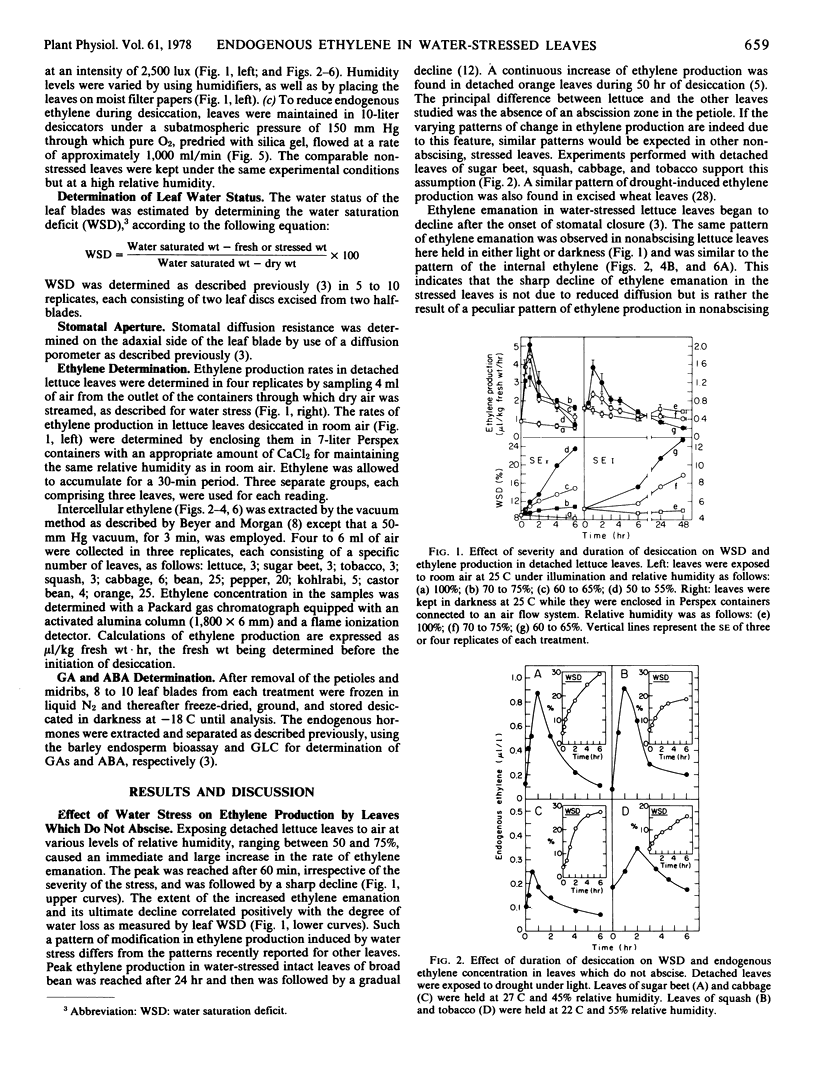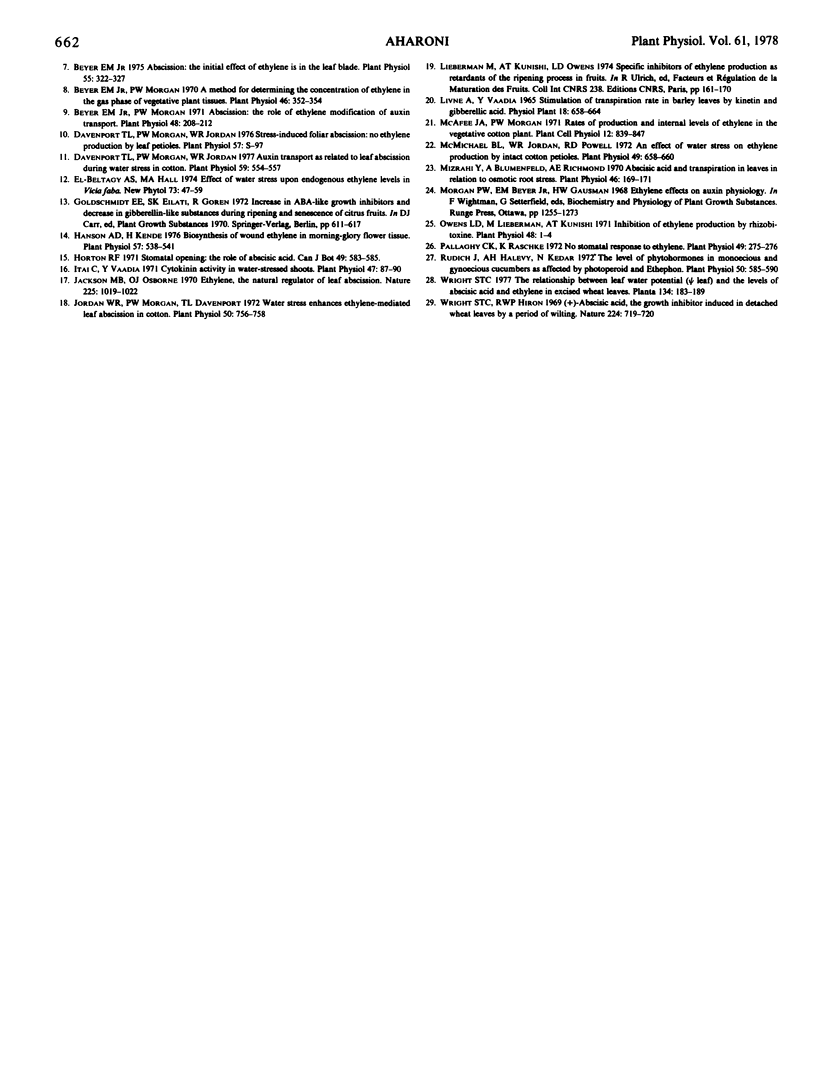Abstract
The pattern of changes in the internal concentration of ethylene in response to water stress was investigated in species with leaves that do abscise and leaves that do not abscise. When leaves which abscise were detached and exposed to dry air for up to 6 hours, a continuous increase of internal ethylene was observed. In water-stressed leaves which do not abscise only a transient rise in ethylene occurred. The peak, which was attained after 30 to 120 minutes, depending on the species studied, was followed by a sharp decline to the initial level. The principal site of ethylene production in response to a short period of water stress was in the blades rather than the petioles in both types of leaves. The internal ethylene level in leaves was reduced by pretreatment with the ethoxy analog of rhizobitoxine (an inhibitor of ethylene biosynthesis) or by maintaining the leaves under subatmospheric pressure. The results obtained by these methods showed that ethylene was not involved in the mechanism of stomatal movement in either turgid or in stressed leaves. Also, the increase in leaf abscisic acid content and the depletion of gibberellins induced by water stress were not related to the internal concentration of ethylene in the detached leaf. The different patterns of drought-induced ethylene production observed in the blades of leaves which exhibit abscission compared with those which do not exhibit abscission may indicate the involvement of ethylene in a primary event in the process of leaf abscission induced by water stress.
Full text
PDF




Selected References
These references are in PubMed. This may not be the complete list of references from this article.
- Abeles A. L. Biochemical Pathway of Stress-induced Ethylene. Plant Physiol. 1972 Oct;50(4):496–498. doi: 10.1104/pp.50.4.496. [DOI] [PMC free article] [PubMed] [Google Scholar]
- Aharoni N., Blumenfeld A., Richmond A. E. Hormonal activity in detached lettuce leaves as affected by leaf water content. Plant Physiol. 1977 Jun;59(6):1169–1173. doi: 10.1104/pp.59.6.1169. [DOI] [PMC free article] [PubMed] [Google Scholar]
- Beardsell M. F., Cohen D. Relationships between Leaf Water Status, Abscisic Acid Levels, and Stomatal Resistance in Maize and Sorghum. Plant Physiol. 1975 Aug;56(2):207–212. doi: 10.1104/pp.56.2.207. [DOI] [PMC free article] [PubMed] [Google Scholar]
- Ben-Yehoshua S., Aloni B. Effect of Water Stress on Ethylene Production by Detached Leaves of Valencia Orange (Citrus sinensis Osbeck). Plant Physiol. 1974 Jun;53(6):863–865. doi: 10.1104/pp.53.6.863. [DOI] [PMC free article] [PubMed] [Google Scholar]
- Beyer E. M. Abscission: the initial effect of ethylene is in the leaf blade. Plant Physiol. 1975 Feb;55(2):322–327. doi: 10.1104/pp.55.2.322. [DOI] [PMC free article] [PubMed] [Google Scholar]
- Beyer E. M., Morgan P. W. A method for determining the concentration of ethylene in the gas phase of vegetative plant tissues. Plant Physiol. 1970 Aug;46(2):352–354. doi: 10.1104/pp.46.2.352. [DOI] [PMC free article] [PubMed] [Google Scholar]
- Beyer E. M., Morgan P. W. Abscission: the role of ethylene modification of auxin transport. Plant Physiol. 1971 Aug;48(2):208–212. doi: 10.1104/pp.48.2.208. [DOI] [PMC free article] [PubMed] [Google Scholar]
- Davenport T. L., Morgan P. W., Jordan W. R. Auxin Transport as Related to Leaf Abscission during Water Stress in Cotton. Plant Physiol. 1977 Apr;59(4):554–557. doi: 10.1104/pp.59.4.554. [DOI] [PMC free article] [PubMed] [Google Scholar]
- Hanson A. D., Kende H. Biosynthesis of wound ethylene in morning-glory flower tissue. Plant Physiol. 1976 Apr;57(4):538–541. doi: 10.1104/pp.57.4.538. [DOI] [PMC free article] [PubMed] [Google Scholar]
- Itai C., Vaadia Y. Cytokinin Activity in Water-stressed Shoots. Plant Physiol. 1971 Jan;47(1):87–90. doi: 10.1104/pp.47.1.87. [DOI] [PMC free article] [PubMed] [Google Scholar]
- Jackson A. O., Larkins B. A. Influence of Ionic Strength, pH, and Chelation of Divalent Metals on Isolation of Polyribosomes from Tobacco Leaves. Plant Physiol. 1976 Jan;57(1):5–10. doi: 10.1104/pp.57.1.5. [DOI] [PMC free article] [PubMed] [Google Scholar]
- Jackson M. B., Osborne D. J. Ethylene, the natural regulator of leaf abscission. Nature. 1970 Mar 14;225(5237):1019–1022. doi: 10.1038/2251019a0. [DOI] [PubMed] [Google Scholar]
- Jordan W. R., Morgan P. W., Davenport T. L. Water Stress Enhances Ethylene-mediated Leaf Abscission in Cotton. Plant Physiol. 1972 Dec;50(6):756–758. doi: 10.1104/pp.50.6.756. [DOI] [PMC free article] [PubMed] [Google Scholar]
- McMichael B. L., Jordan W. R., Powell R. D. An effect of water stress on ethylene production by intact cotton petioles. Plant Physiol. 1972 Apr;49(4):658–660. doi: 10.1104/pp.49.4.658. [DOI] [PMC free article] [PubMed] [Google Scholar]
- Mizrahi Y., Blumenfeld A., Richmond A. E. Abscisic Acid and transpiration in leaves in relation to osmotic root stress. Plant Physiol. 1970 Jul;46(1):169–171. doi: 10.1104/pp.46.1.169. [DOI] [PMC free article] [PubMed] [Google Scholar]
- Owens L. D., Lieberman M., Kunishi A. Inhibition of ethylene production by rhizobitoxine. Plant Physiol. 1971 Jul;48(1):1–4. doi: 10.1104/pp.48.1.1. [DOI] [PMC free article] [PubMed] [Google Scholar]
- Pallaghy C. K., Raschke K. No stomatal response to ethylene. Plant Physiol. 1972 Feb;49(2):275–276. doi: 10.1104/pp.49.2.275. [DOI] [PMC free article] [PubMed] [Google Scholar]
- Rudich J., Halevy A. H., Kedar N. The level of phytohormones in monoecious and gynoecious cucumbers as affected by photoperiod and ethephon. Plant Physiol. 1972 Nov;50(5):585–590. doi: 10.1104/pp.50.5.585. [DOI] [PMC free article] [PubMed] [Google Scholar]


